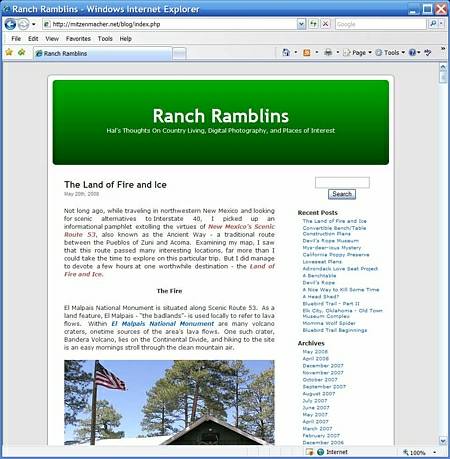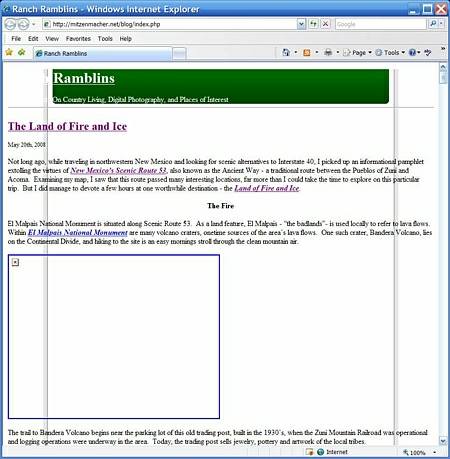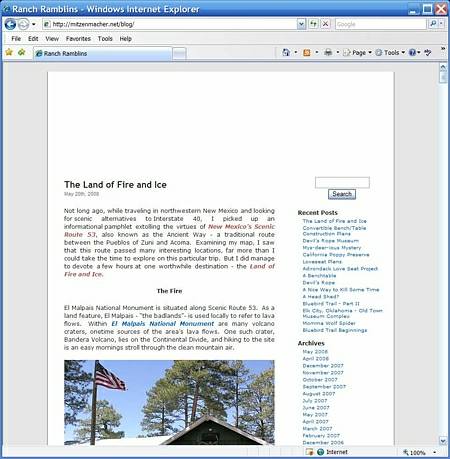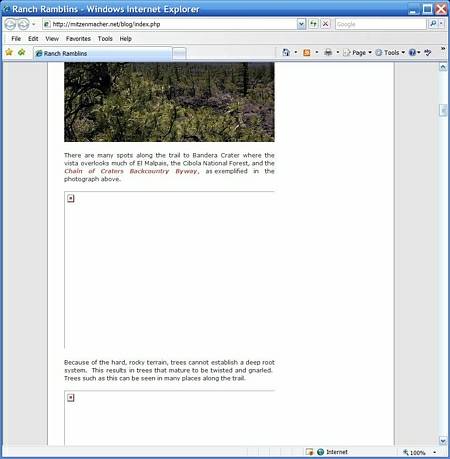Help! I need your input to try and debug a misbehaving blog.  Here is the problem. When I surf on over to my blog URL, I should see a web page that looks like the screen capture seen here –
Unfortunately, that is not what is showing up on my screen.  Here is the page that I usually see these days-
The page does not appear to recognize any formating -Â the header does not line up correctly, the side-bar has been pushed down to the bottom of the page, the background has disappeared, and the photographs have failed to load.
If I hit the refresh button on my browser, after a few iterations I might get some of the pictures to load, but the header remains missing-in-action, as seen above.
Sometimes, several of the photographs will load correctly, but others will not, as seen in the screen capture above.
And at yet other times, I see a partial header, with no photographs loading, while some of the page formating remains in tact.
I need to try and isolate the problem, but since I have no other computer access beyond my home network, I cannot see what my blog looks like to other readers.  Here is where I need your help. If you have stumbled across this page by any chance, please leave a comment telling me if the page is formated correctly for you, or whether it is messed up on your screen.
This problem occurs on my computer using either Internet Explorer or Firefox, so I don’t think it is a browser problem.
I am using the standard default Wordpress Kubrick theme, using only a few of the standard sidebar widgets, with no modifications, so I doubt that the Wordpress theme is the culprit. Also, with enough browser refreshes, the page will eventually load correctly, so this seem to indicate that the problem lies outside the theme templates.
My trouble shooting instincts are telling me that this is somehow related to my web host, and that I will have to deal with their tech resources to solve the problem, but before I embark on that path, I want to try and eliminate the possibility that my satellite Internet provider is not somehow to blame (you would be surprised how many things satellite Internet service screws up)!
PS – It occurs to me that if you are experiencing the same problems with this web page as I am, than the screen captures above might not show up – ain’t technology fun? ;)








Hal – everything appears correct to me and has for a long time. I check your blog every morning to see if it has been updated and can’t remember a time when it looked like your screenshots. I am using I.E. on a PC running XP. Hope you find your answer.
Hal, sorry I can’t provide any absolute solution, but everything is appearing correctly (and loading quickly) for me. I just checked it on WinXP running IE6, Linux (Ubuntu 7.04) running FireFox and I’m writing this from a Mac (OS X Leopard 10.5.2) running Safari 3.1.1. And my ISP is Verizon if that matters.
Good luck!
It’s working for me (at work, XP, Firefox, AT&T ISP), though I had noticed in the past that the stylesheet or images would be missing when surfing from home (XP, Firefox, wildblue).
Hal, the content here is fine.
Here are three possible problems:
1) Windows temporary files have exceeded a mystery limit, which affects man applications. Io eliminate this possibility, perform a Disk Clean up (right click disk, Properties, Disk Cleanup) and make sure temporary files is selected.
2) Your network connection is unreliable, and some of the connection threads are timing out. Indication of this would be that all page elements load slowly in general, with some seemingly never completing.
3) AntiVirus / Security software is *notorious* (esp. Kaspersky) for updates wreaking havoc on user’s web browsing. The problem occurs when the heuristics for their web or file proxies are botched. Test out the AV/Security theory by completely disabling your AV software and retesting after (1) and (2) have been ruled out.
—
MrC
Ed and Ed, Thanks for the feedback – it is helping me with the diagnosis of the problem (I hope).
Duane – Thanks for the info.
What is interesting to me is that you are the only person to report a missing style sheet or photographs, but only while at home. Since we both use Wildblue at home, I think this might be my first line of investigation.
MrC – Thanks for the input.
1) Disk cleanup – I ran the utility as you suggested (which I generally do periodically), but the problem persists.
3) AntiVirus software – the problem persists even after disabling my AV software.
2) Unreliable network connection – I presume you are refering to my network connection to the Internet. I am using the following home network architecture:
File server – connected directly to Wildblue satellite modem via Ethernet port. It acts as the router for my other networked computers, via Microsoft Internet Connection Sharing.
Remote computers – Networked to file server (and ICS) on a peer-to-peer network via USB wireless network adaptors.
My home network works well in all other respects.
My gateway to the Internet is via Wildblue satellite, which, as you may recall from some previous posts, provides abysmal service. Extreme latency, and frequent timeouts (in ping tests) are the norm for Wildblue service, but the only web pages that fail to load properly for me are the Ranch Ramblins web pages.
Duane has reported seeing these same symptoms from time to time on his home computer, which is also on Wildblue. Perhaps Wildblue and my web host (Dreamhost) aren’t getting along together. I’ll keep investigating to see if I can come up with the solution.
Ok, sounds like you’ve eliminated the first suspects. The problems you experience are not uncommon; in fact, I’ve seen hundreds of reports of this sort on various user boards.
Is this a recent problem, or has it been a long term lingering one?
Also be sure that your system’s firewall is not causing the problems (Windows Firewall, or whatever you use).
Personally, I would drop the ICS setup, and purchase an inexpensive router/firewall appliance and connect all your components directly to the device (WAN port goes to Wildblue modem, all other PCs go to various LAN ports on appliance). This is far more reliable that ICS. In fact, with ICS in the picture, diagnosis is far more difficult. Try connecting a single PC to your wildblue modem and testing that setup.
There are my things that can cause the behavior you are experiencing, and diagnosis is difficult for those not familiar with web and network protocols.
Because of the way web page requests work, certain types of problems occur only in this domain (from a typical user’s point of view). Keep in mind they web requests are comprised of numerous, simultaneous network connections, each one generally requesting a single component from a web page (images, style sheets, java scripts, etc.). The connections are quick, and short-lived, with a variety of packet sizes. Contrast this to longer lived network connections, that typically fill a network packet to capacity.
The following, plus some light description, are things to consider.
1) MTU
Maximum tranmission unit. Typical Ethernet packet size is 1514 bytes, with a maximum payload of 1500 bytes. For encapsulating protocols such as PPPoE which consumes some bytes for the encapsulation data, it is necessary to reduce the MTU such that the payload and the encapsulation data all fits within the max 1514 bytes. Often this is done automatically, but not always. Lowering the MTU may solve the problem. See: http://support.microsoft.com/default.aspx?scid=kb;en-us;283165
2) MSS, fragmententation and routers that block ICMP
Packets traverse numerous routers, each with its own limitations with respect to packet sizes. So (frail) mechanisms were invented to ensure that packets can traverse from router to router to and from the final destination, all the while respecting each piece of hardware’s limitations. This is accomplished by routers sending an ICMP message instructing the sender to reduce the maximum packet size. This all takes place transparently, but unfortunately, many routers are configured (in the guise of security) to block ICMP messages. Ultimately, packets get dropped, and the symptoms are network oddities as you experience. If your router/modem has a setting to block ICMP requests, test unsetting it.
3) Poor local caching DNS servers
Many commodity routers implement and maintain their own local caching domain name server. This is done to speed up name lookups, however home routers/firewalls/appliances generally have insufficient memory and have poor DNS implementations, thus causing seemingly random network failures (again, from a user’s point of view). If windows says your DNS server is the IP address of your router, instead use either your ISPs DNS servers, or some free ones such as those provided by opendns.
Unfortunately, the way to resolve problems of this nature is by first eliminating the obvious trouble areas, and then diagnosing at the protocol request level. You’ll need to basically monitor the requests from your browser to and from the web host. You can install and use a tool such as Wireshark (http://www.wireshark.org/) to do this. You will setup a packet capture to capture all packets to / from your web host on port 80 (the HTTP port). You are looking to see which requests reach your browser, and which ones don’t. Alternatively, another powerful tool is Proxomitron (http://www.proxomitron.info/files/index.html), which is a web proxy. It becomes a middleman between your browser and the remote host, where you can watch the HTTP requests in the log window.
Your browser requests first the main page itself, and then it requests all the referred content. So, you’ll have to match the content requested against the content actually received.
Hope this helps take you to the next steps.
MrC – Thanks for this important help. Your comment didn’t appear in the post because it was being held in the WordPress moderation queue (due to several included links). I’ll change this setting so it doesn’t happen again.
It looks like I have my work cut out for me! I’ll try all of your valuable and appreciated suggestions as soon as time permits.
When I was a teenager, I used to relish working on automobiles, but as I matured, I grew to prefer a vehicle that was simply reliable and comfortable.
Similarly, back in the days of CP/M and DOS, I enjoyed debugging, trouble shooting and tinkering with settings in order to get software and hardware to work. Now, I just want to sit at my computer and accomplish the task at hand. Alas, that day will never come (at least in my lifetime).
I’ll keep you posted on my continuing trouble shooting efforts.
I know this response is way outdated, but, I too am on Wildblue using Firefox on Ubuntu and the page loads properly for me.
Cool site, love the info.